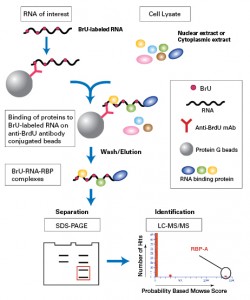You have an RNA of interest aka your favorite RNA. The question is: which RBPs interact with it? Who are these RBPs and what are their intentions with your precious RNA?
It’s not yet known how diseases are regulated or at which point protein transcription/translation are altered to cause disease. Studies have found that there are specific RNA Binding Proteins (RBPs) for their respective mRNA. The nature of this interaction is dynamic. For example, regulatory signals influence binding of RBP and RNA, one RNA can have more than one RBP, and one RBP can bind with different RNAs(1). Researchers are working hard to develop a greater knowledge base for how these diverse proteins interact with many different RNAs. In order to better understand the dynamic nature of this transcriptional regulation, RNP (ribonucleoprotein) complexes are being investigated. As you know, it is important to carry this investigation on with a system that involves the least amount of outside influence. After all, you want to capture the “true” relationship of RBPs and their mRNAs.
RiboTrap Kit From MBL International

One method for investigating the RBP and RNA interaction is to do an RNA pull down assay. IP’s are great for investigating interactions. MBL’s RiboTrap kit comes with an anti-BrdU antibody and various buffers. This antibody will isolate the labeled mRNA of interest and pull down the mRNA and any proteins binding with it, in (or under) native conditions. MBL’s kit utilises three different wash buffers so you can analyse weakly bound proteins or very tightly bound proteins. There is the option of using a basic buffer, high salt buffer, or strong detergent buffer. Be cautious though! Just because you find the strongest interaction using any or all of the three buffers, it doesn’t necessarily mean this is the function RBP/RNA interaction. It’s just the strongest. Be sure to plan more fun experiments to characterise the functionality of any newly discovered binding.
Once you run your proteins out on SDS-PAGE gel, excise the bands, and analyse using LC-MS/MS. You now have a better picture of interactions between your favorite mRNA and what RBPs bind to it. Now to figure out the intentions…
1. Glisovic, Tina, Jennifer L. Bachorik, Jeongsik Yong, and Gideon Dreyfuss. “RNA-binding Proteins and Post-transcriptional Gene Regulation.” FEBS Letters 582.14 (2008): 1977-986.
